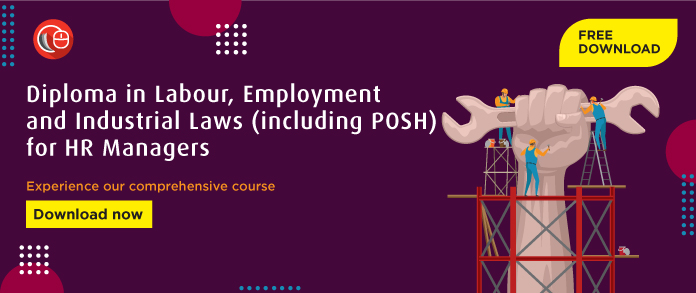This article is written by Sunita who is pursuing a Diploma in Labour, Employment and Industrial Laws for HR Managers from Lawsikho.
Table of Contents
Introduction
Article 43A of the Constitution of India deals with the Workers’ participation in the management and this comes under DPSP (Directive principle of state policy). Workers’ participation in management is one of the important elements of industrial democracy. It is a system where employees have a say in the decision of management. Workers participation in management refers to the participation of the workers in the decision-making process of the organization. This has an incredibly positive impact on the mental and psychological health of the workers, and they are associated with the organization. The concept of workers’ participation in management is based on the Human Relations approach to Management which brought about a new set of values to labor and management. WPM focuses on sharing power with the workers who are engaged in work rather than being concentrating on one hand. Through WPM workers can share and express their views, ideas, and contribute to the decision-making process. Sharing power with workers and listening to their opinion will develop loyalty and trust towards the organization and have a positive impact on the productivity of employees.
Historical background of WPM: in 1920, Mahatma Gandhi had introduced the concept of WPM in India. In Ahmedabad, textile workers and employers agreed to resolve the dispute through joint participation. In 1958, TISCO had set up committees for workers to participate in various matters related to the organization.
According to ILO : ‘Workers’ participation may broadly be taken to cover all terms of association of workers and their representatives with the decision-making process, ranging from exchange of information, consultations, decisions, and negotiations to more institutionalized forms such as the presence of workers’ members on management or supervisory boards or even management by workers themselves as practiced in Yugoslavia”.
ILO has summarized the main implication of Workers’ participation in management as:
- Workers may have ideas or opinions that can be useful.
- Workers will work more intelligently and with loyalty if they will be informed about the reason and intention of a particular decision that is taken in a participative atmosphere.
The main characteristics of workers participation in management
- Participation implies practices that increase the scope for employees’ share of influence in the decision-making process with the assumption of responsibility.
- Participation presumes willingly acceptance of responsibilities by the employees.
- Workers participate through their representatives in the decision-making process. Though workers are participating through their representative, it should not be mixed with collective bargaining, as WPM is based on mutual trust, information sharing and collective bargaining is more of power play and creating pressure on management, negotiations.
- The logic behind workers’ participation is that they put their efforts, invest their labor for the organization, and after all, they are the ones who will be affected by the decision most. Also, they are contributing to the outcome, hence they have the right to give their opinion.
- It can be formal or informal, but in both cases, it is a system of communication where workers can express their views. In formal participation, various committees and councils come into the pictures such as the works committee, Joint management council, safety committee, etc. whereas informal participation may be like supervisor consulting workers on leave, promotion, transfer, etc.
- It gives psychological satisfaction to employees, as they spend most of the time in the organization, and commitment and recognition from the organization give them psychological satisfaction.
Objectives of the workers participation in management
The objective of WPM may vary from one country to country, state to state, level to level, industry to industry, etc. such as to co-determine at the various levels of enterprises in Germany, in Japan it is to promote a good understanding of business and production issues between management and labor, for India it can be creating a socialist society.
Few commons objectives are:
- Avoid exploitation of workers by the management.
- It will help to create a democracy in the organization.
- Promote the better understanding between worker and management and help to resolve conflicts.
- It will give an opportunity to the employee for self-expression which will lead to industrial peace.
- It will help to create a good communication system in the organization.
- It will reduce the resistance and help workers to accept the change. For growth and development of the organization it is mandatory for the organization to welcome the changes.
Forms of participation
Different forms of participation are:
Collective Bargaining: Collective bargaining is the process of negotiation between a group of employees and the employers to determine the salary, working condition and benefits and other rights of the employees. Workers usually prefer to use this tool rather than ask for a share in management.
Work Council/Committee: Group of people who are representative of employees and employers form this kind of committee with the aim to maintain cordial and harmonious relations between employee and employer.
Joint Management Councils: This council is advisory and consultative in nature and has an equal number of representatives from employee and employer. Neither management nor employee take these councils seriously.
Board Representation: This is the highest form of participation. Under this type of participation few employees are elected on board of directors. The main idea of this is to safeguard the interest of the employees and maintain a good relationship between the employer and employee.
Workers Complete Ownership: This form of participation is called Self-Management.
Under this form employees get complete control over the management of enterprise though the elected board. This system is extremely popular in Yugoslavia. In this system two different sets of people perform two types of functions, managerial and Operative.
Co-partnership: In this form workers participate in the share capital of their own company. In this scheme, workers buy the equity share of the company. Workers can make the payment in installments, advance, or loan or can get the assistance from the employer. As a shareholder they take part in the management. However, their participation is limited, hence not preferred by the trade union.
After knowing the form of participation, it becomes necessary to know, to what level and extent workers can participate in decision making. The participation of workers at a different level is different, the degree and the nature of the application are different at all the levels.
Following are the level of participation:
Informative Participation: This refers to the management’s sharing of information with the workers on matters related to workers such as balance sheet, production, and the financial health of the company.
Consultative participation: In this type of participation, workers can give their views on the matters related to them, but acceptance or non-acceptance of their opinion depends on the employers. Here, the role of the employee is limited to giving opinion only.
Associative participation: This is an improved form of consultative participation. Here, it is considered that this is the moral duty of the employer to acknowledge and accept and implement the unanimous decisions of employees.
Administrative participation: In this type of participation, the decision is already taken and implemented by the worker. Here the degree of sharing power and responsibility by the worker is more as compared to other levels of participation.
Decisive Participation: Here decisions on matters like production, employee welfare, etc. are taken by the worker and management jointly after a discussion.
Evaluation of worker’s participation in management in India
Despite the good intentions and development of various WPM schemes over the period, the scheme has not been a success, the result of the scheme is even not satisfactory.
Why WPM is not successful
Ideological difference
There is an ideological difference between the employer and worker regarding the scheme or there is a lack of understanding of the concept. Employee wants to implement it simultaneously at all the levels, whereas the employer wants to introduce participation slowly at Board level. So, the result is both are not accepting the scheme entirely
Failure to imbibe the spirit of participation
Parties not able to understand the spirit of participation. Workers representatives think that it is a grievance redressal tool, like salary, work conditions, better security, etc. On the other hand, employers feel that the participation of workers may take away their decision-making power.
Absence of a strong trade union
In India, there is a lack of strong trade unions. There is a multiplicity of unions and inter-union rivalry also exists. All these make the scheme ineffective.
Illiteracy of Workers
Most of the workers are illiterate and the same with their representative either they are illiterate or less educated. This is one of the major reasons behind the failure of WPM, as they have participated at various levels and due to lack of knowledge, they are unable to participate effectively.
Improper Implementation
One of the other reasons behind the difficulty ineffective working of the scheme is the delay in implementation of the decisions taken by the various committees which creates frustration among the workers and results in a lack of interest in WPM.
Conclusion
Various research shows that WPM has a significant role in increasing the productivity of the organization. It gives them the feeling of belonging which is important for increasing productivity and the internal relation of the organization. The government had also taken the step towards WPM by the setup of INDUSTRIAL DISPUTES ACT, 1947 having the scope of WPM. Despite all this hard work WPM has not got success. We want to increase the GDP of the economy which can be increased by increasing the production of business and this is possible by effective implementation of WPM. For effective implementation, few measures can be taken like creating a democratic environment in the organization, the objective should be clearly defined, no delay in implementation of the decision, training, and education should be given to the employees.
Students of Lawsikho courses regularly produce writing assignments and work on practical exercises as a part of their coursework and develop themselves in real-life practical skill.
LawSikho has created a telegram group for exchanging legal knowledge, referrals and various opportunities. You can click on this link and join:
 Serato DJ Crack 2025Serato DJ PRO Crack
Serato DJ Crack 2025Serato DJ PRO Crack











 Allow notifications
Allow notifications



